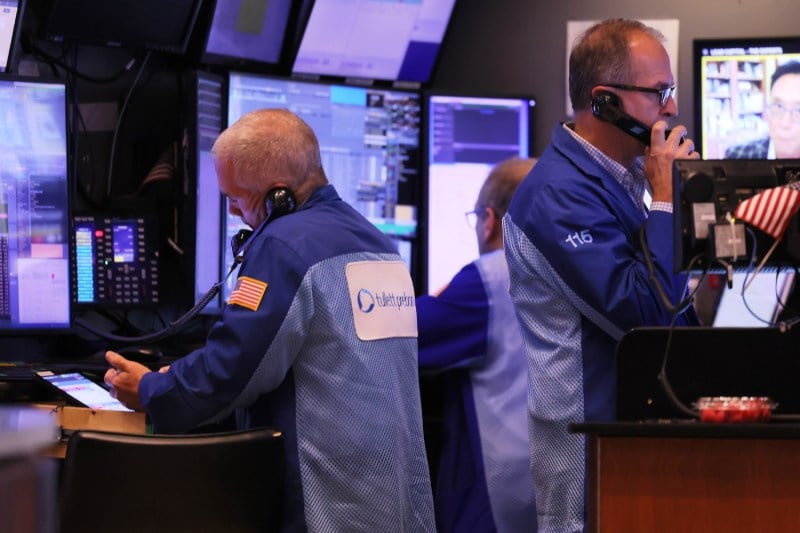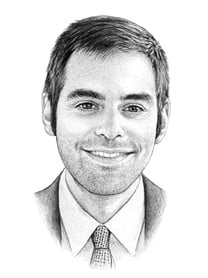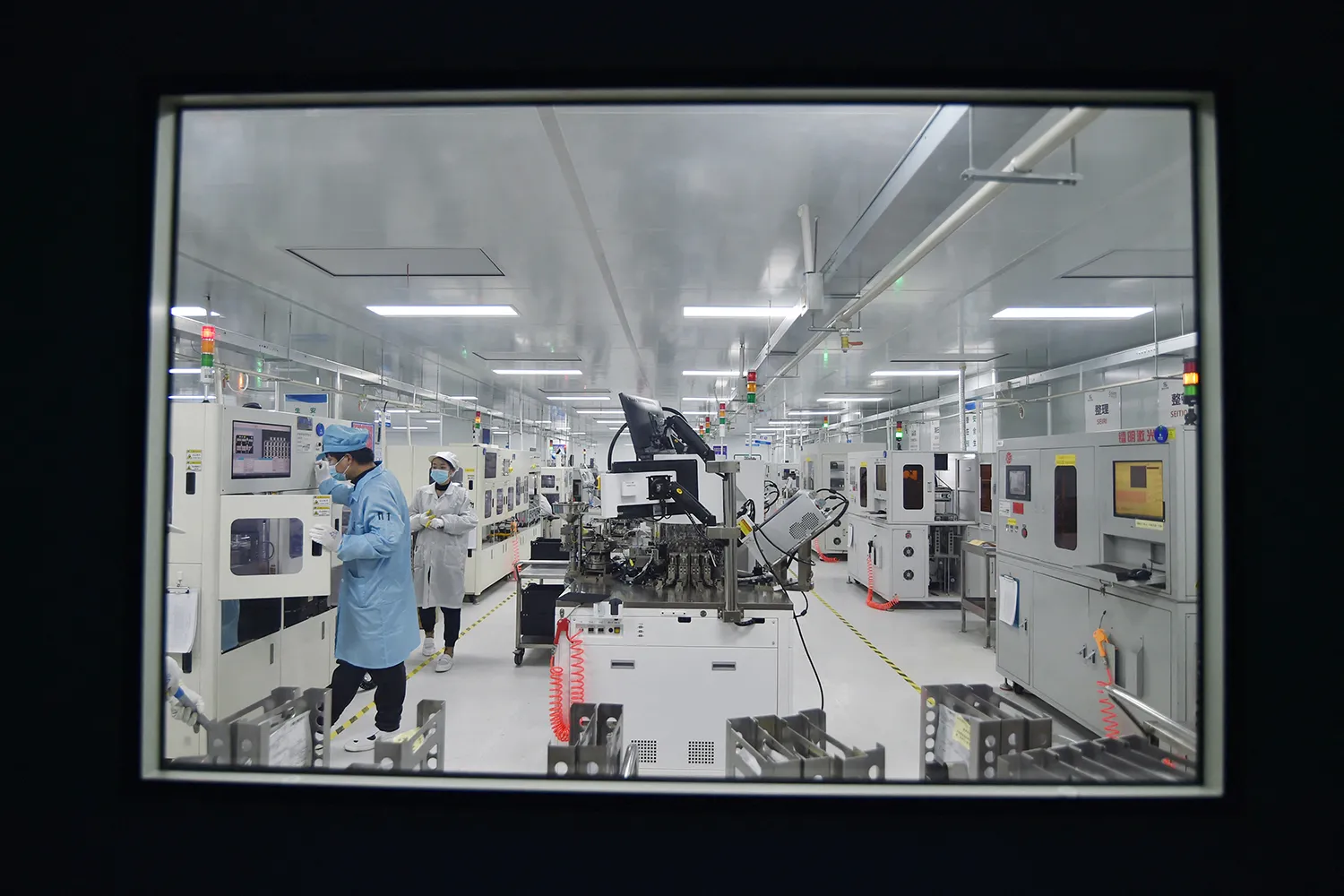Trump’s Trade Contradictions Come Home to Roost

Trump’s Trade Contradictions Come Home to Roost
The dollar is falling instead of rising—a defiance of tariff theory that shows investors are losing faith in America.
Traders work on the floor of the New York Stock Exchange during afternoon trading in New York City on Sept. 26, 2023. Michael M. Santiago/Getty Images
U.S. President Donald Trump has long been of two minds about the dollar. He has said he wants it weaker to make American products cheaper in global markets, but he has also said he wants it strong so it remains the world’s dominant reserve currency.
Those two objectives never made sense together. And now, as his tariff war threatens the U.S. economy, we’re seeing reality bite. Trump is getting the weakness he wants. The dollar has fallen 5 percent against other major currencies since his inauguration in January. But the strength he promised is nowhere to be seen.
U.S. President Donald Trump has long been of two minds about the dollar. He has said he wants it weaker to make American products cheaper in global markets, but he has also said he wants it strong so it remains the world’s dominant reserve currency.
Those two objectives never made sense together. And now, as his tariff war threatens the U.S. economy, we’re seeing reality bite. Trump is getting the weakness he wants. The dollar has fallen 5 percent against other major currencies since his inauguration in January. But the strength he promised is nowhere to be seen.
Last year, one of Trump’s key advisors, Stephen Miran, imagined a so-called Mar-a-Lago Accord in which the United States would essentially require its trading partners to help bring down the dollar’s value. That would have been, the theory goes, engineering a devaluation from a position of strength.
Instead, the dollar is falling because of perceptions of American weakness. Investors are worried that in the short run, the trade war will cause a recession in the United States, and that in the long run, loss of confidence in the United States will jeopardize the dollar’s role at the center of global commerce. “The blowback of U.S. tariffs onto the U.S. domestic economy leaves the dollar naked,” Chris Turner, ING’s global head of markets, wrote in a client note.
Trump is right that a strong dollar is a mixed blessing. By making imports cheaper and exports more expensive, it hurts workers in businesses that compete in global markets. Trump has vowed to reverse what he calls the hollowing out of the American economy, and bringing down the dollar is, along with tariffs, a key part of his platform.
But a strong dollar also lowers prices for American consumers. And the conviction that the United States will preserve the dollar’s value is a key reason that other nations have been willing and eager to hold dollars as emergency reserves and to use the U.S. currency in international transactions.
According to a Brookings Institution analysis last year, dollar assets are 59 percent of global foreign exchange reserves, and the dollar is used in 58 percent of international payments, excluding payments within the eurozone. That’s even though the U.S. share of global economic output has shrunk to about a quarter.
That dominance gives the United States important geopolitical leverage. In a Nov. 30 post on Truth Social, Trump warned Brazil, Russia, India, China, and South Africa not to challenge the dollar. “They will neither create a new BRICS Currency, nor back any other Currency to replace the mighty U.S. Dollar,” he wrote. If they do, he wrote, they “will face 100% Tariffs.”
Trump’s goal all along has been to shed the burdens of a strong dollar while keeping the good parts. Instead, burden-shedding has been far from painless. Import prices are rising, trading partners are retaliating against American exports, and Trump has pivoted from his first-term message that “trade wars are good, and easy to win” to warning that “there’ll be a little disturbance” on the way to greatness.
In past episodes of economic turbulence, U.S. financial markets did relatively well because the United States was perceived as a safe haven for investors—even in episodes such as the global financial crisis in which the United States was a main cause of the trouble. That’s not how things are going this time. The U.S. stock market indexes have fallen right along with those of Europe, China, and Japan. That’s more evidence that the United States is losing its privileged position in global finance. Investors and governments don’t want to hold dollar assets if they’re no longer a reliable storehouse of wealth.
The dollar’s decline to date has been smaller than the drop in stock prices, to be sure, but the surprise is that the dollar has fallen at all. Economic theory says that when a country raises tariffs, its currency should ordinarily rise.
Why would tariffs strengthen the dollar? Supply and demand. The tariff initially reduces American demand for imports, so fewer dollars go abroad. When dollars are relatively scarce, their price in terms of other currencies goes up. The dollar’s rise partially offsets the tariff’s initial effect by making imports cheaper. The economist Olivier Jeanne estimated in 2020 that tariff-related news explained about one-third of the decline in China’s renminbi in 2018.
The notion that interventions in trade cause offsetting actions in the currency market is hardly fresh. In 1752, David Hume, the Scottish philosopher and economist, wrote that restrictions on exports “serve to no other purpose than to raise the exchange against them.”
The reason the dollar isn’t rising in this episode, contrary to trade theory, is that fears about the health of the U.S. economy are putting downward pressure on the dollar, and that’s swamping the upward pressure coming from predicted trade flows.
Trump’s mixed feelings about the strength of the dollar aren’t the only contradiction in his trade policy. Trump has promised that tariffs will raise revenue (possibly enough to eliminate the income tax!) and also bring manufacturing jobs back to the United States.
But as with the weak/strong dollar conundrum, those two objectives can’t both be accomplished at once. If tariffs raise a lot of money, it’s only because foreign goods are still coming into the United States. In that case, tariffs won’t restore manufacturing jobs. Conversely, if tariffs do restore manufacturing jobs, it’s only because they dry up the inflow of imports, which means they won’t raise a lot of money. A basic economic principle is that you can’t have your cake and eat it, too (despite what former British Prime Minister Boris Johnson said).
The Dutch economist Jan Tinbergen, were he still alive, could have told Trump that he’s trying to accomplish too many things at once with tariffs. Tinbergen, who in 1969 received the first Nobel Memorial Prize in Economic Sciences, said that each policy target must have its own instrument. The intuition is that a pilot can’t land at the average of two airports.
(In a recent appearance on CNN, U.S. Treasury Secretary Scott Bessent said that the conundrum could be solved with sequencing: At first there would be a lot of revenue from tariffs, but it would be a “shrinking ice cube.” Over time, imports would fall and domestic manufacturing would build up. Taxes on that economic activity would replace tariff revenue. OK, maybe.)
Then there’s the perennial question of whether Americans or foreigners will bear the cost of the Trump tariffs. On paper, the tariffs are paid at the point of importation, but that doesn’t answer the question of who ultimately bears their cost. Bessent thinks he knows. Echoing his boss, he told CBS News in early March that China “will eat any tariffs that go on.”
But that all depends on which side has market power, economists say. If a Chinese producer feels it must swallow the cost of the tariff to retain its American customers, then it will bear the full cost of the tariff. That’s Bessent’s scenario. On the other hand, if the Chinese producer can get away with pushing the cost of tariffs onto its customers, then the final price will go up by the amount of the tariff, and Americans will bear their full cost.
The reality is most likely somewhere between those extremes. China and other exporters didn’t “eat” the tariffs the last time Trump was president. Americans did. “U.S. tariffs continue to be almost entirely borne by U.S. firms and consumers,” the economists Mary Amiti, Stephen J. Redding, and David E. Weinstein found in a 2020 article about the tariffs imposed in 2018 and 2019.
Many mainstream economists agree that tariffs can be legitimate tools in certain circumstances. For example, the World Trade Organization allows countries to levy tariffs to protect themselves from unfair practices by trading partners, such as subsidies. Some economists also defend tariffs that protect “infant industries”—ones that need to be sheltered from competition as they get going.
Trump, though, sees tariffs not as necessary evils, but as good in their own right. He told NBC News recently that the 25 percent tariffs on imported cars are “absolutely” permanent. He also likes to use tariffs to achieve goals far removed from trade, such as cutting down on illegal immigration and fentanyl trafficking. Most recently, he threatened to impose tariffs on countries that buy Russian oil if Russia thwarts efforts to reach a cease-fire in Ukraine.
It’s hard to find a through line in Trump’s thinking, but some of his advisors have tried.
The aforementioned Miran, who chairs Trump’s Council of Economic Advisors, laid out in November a framework for at least part of Trump’s wide-ranging tariff agenda—the Mar-a-Lago Accord. It included an attempt to square the circle on dollar valuation, laying out how the dollar could be cheapened while remaining the dominant currency for reserves and transactions.
Miran argued that the dollar is overvalued because other nations are accumulating dollars to invest in U.S. assets, and that as a result American industry has become hollowed out because its products are too expensive.
Miran acknowledged in the paper that cutting trade deficits would put upward pressure on the dollar, not weaken it. His solution is to form a coalition of the willing to intervene to push down the dollar—against market forces—in a modern version of the Plaza Accord of 1985 that lowered the dollar’s value against the Japanese yen, the West German Deutsche mark, and other currencies.
High tariffs would give the United States “negotiating leverage” to get trading partners’ help in pushing down the dollar, Miran wrote. Trading partners that still didn’t get with the devaluation program would face high tariffs and would risk losing the protection of the U.S. military, Miran added, in a flourish that may well have endeared him to Trump.
Miran said any scenario for dollar manipulation would entail “a much stronger demarcation between friend, foe and neutral trading partner.” Bessent has used similar language, talking about placing countries in green, yellow, or red “buckets” depending on their willingness to comply with American demands.
This spring, the economist Maurice Obstfeld analyzed the administration’s tariff policy and dollar policy in a paper presented at the Brookings Papers on Economic Activity conference on March 27. Obstfeld, a professor at the University of California, Berkeley, is a former chief economist of the International Monetary Fund.
Obstfeld doesn’t think much of the proposed Mar-a-Lago Accord. “Exchange rate effects are likely to be short-lived unless the promised changes in macroeconomic fundamentals are forthcoming,” he wrote. Also, he wrote, “It is unclear why other countries would go along: few view their currencies as undervalued.”
By igniting a tariff war with America’s trading partners, Trump has entered a hall of unintended consequences. It is a disorienting place for an inexperienced traveler, with lots of dead ends, blind turns, and Escher-like stairs that seem to go up but are actually going down. The president could benefit from some expert guidance to find his way out.
Peter Coy is a journalist who writes about economics.
More from Foreign Policy
-

American flags are draped around tables and pipes in a small factory room as women work at sewing machines to produce them. Tariffs Can Actually Work—if Only Trump Understood How
Smart trade policy could help restore jobs, but the president’s carpet-bomb approach portends disaster.
-

Donald Trump looks up as he sits beside China’s President Xi Jinping during a tour of the Forbidden City in Beijing on Nov. 8, 2017. Asia Is Getting Dangerously Unbalanced
The Trump administration continues to create headlines, but the real story may be elsewhere.
-

Trump announces tariffs Trump’s Wanton Tariffs Will Shatter the World Economy
Economic warfare is also a test for U.S. democracy.
-

The Department of Education building in Washington, DC on March 24. Why Republicans Hate the Education Department
Broad popular support means that even Ronald Reagan failed at dismantling the agency.









Join the Conversation
Commenting on this and other recent articles is just one benefit of a Foreign Policy subscription.
Already a subscriber?
.
Subscribe
Subscribe
View Comments
Join the Conversation
Join the conversation on this and other recent Foreign Policy articles when you subscribe now.
Subscribe
Subscribe
Not your account?
View Comments
Join the Conversation
Please follow our comment guidelines, stay on topic, and be civil, courteous, and respectful of others’ beliefs.
Change your username |
Log out
Change your username:
CANCEL
Confirm your username to get started.
The default username below has been generated using the first name and last initial on your FP subscriber account. Usernames may be updated at any time and must not contain inappropriate or offensive language.